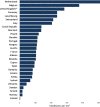Description of Emergency Medical Services, treatment of cardiac arrest patients and cardiac arrest registries in Europe
- PMID: 33076942
- PMCID: PMC7569761
- DOI: 10.1186/s13049-020-00798-7
Description of Emergency Medical Services, treatment of cardiac arrest patients and cardiac arrest registries in Europe
Abstract
Background: Variation in the incidence, survival rate and factors associated with survival after cardiac arrest in Europe is reported. Some studies have tried to fill the knowledge gap regarding the epidemiology of out-of-hospital cardiac arrest in Europe but were unable to identify reasons for the reported differences. Therefore, the purpose of this study was to describe European Emergency Medical Systems, particularly from the perspective of country and ambulance service characteristics, cardiac arrest identification, dispatch, treatment, and monitoring.
Methods: An online questionnaire with 51 questions about ambulance and dispatch characteristics, on-scene management of cardiac arrest and the availability and dataset in cardiac arrest registries, was sent to all national coordinators who participated in the European Registry of Cardiac Arrest studies. In addition, individual invitations were sent to the remaining European countries.
Results: Participants from 28 European countries responded to the questionnaire. Results were combined with official information on population density. Overall, the number of Emergency Medical Service missions, level of training of personnel, availability of Helicopter Emergency Medical Services and the involvement of first responders varied across and within countries. There were similarities in team training, availability of key resuscitation equipment and permission for ongoing performance of cardiopulmonary resuscitation during transported. The quality of reporting to cardiac arrest registries varied, as well as the data availability in the registries.
Conclusions: Throughout Europe there are important differences in Emergency Medical Service systems and the response to out-of-hospital cardiac arrest. Explaining these differences is complicated due to significant variation in how variables are reported to and used in registries.
Keywords: Cardiac arrest registries; Dispatch; Emergency Medical Services (EMS); Epidemiology of cardiac arrest; Out-of-hospital cardiac arrest.
Conflict of interest statement
Ingvild Tjelmeland: has nothing to disclose.
Siobhan Masterson: has nothing to disclose.
Johan Herlitz: has nothing to disclose.
Jan Wnent: has no financial COI to be declared. Jan Wnent is member of the steering commitee of the German Resuscitation Registry and member of the EuReCa study managment team.
Leo Bossaert: has nothing to disclose.
Fernando Rossell Ortiz: has nothing to disclose.
Kristin Alm-Kruse: has nothing to disclose.
Berthold Bein: reports personal fees from Edwards Life Sciences, personal fees from CSL Behring, personal fees from Pharmacosmos, personal fees from Ferrer, personal fees from Cytosorbents, personal fees from TEVA Ratiopharm, outside the submitted work.
Gisela Lilja: has nothing to disclose.
Jan-Thorsten Gräsner: reports personal fees and other from Weinmann: Emergency, personal fees and other from Philips Medical, personal fees and other from Fresenius, personal fees from Bard, personal fees and other from Zoll, outside the submitted work.
Figures




References
-
- Zive DM, Schmicker R, Daya M, Kudenchuk P, Nichol G, Rittenberger JC, et al. Survival and variability over time from out of hospital cardiac arrest across large geographically diverse communities participating in the Resuscitation Outcomes Consortium. Resuscitation. 2018;131:74–82. doi: 10.1016/j.resuscitation.2018.07.023. - DOI - PubMed
-
- Beck B, Bray J, Cameron P, Smith K, Walker T, Grantham H, et al. Regional variation in the characteristics, incidence and outcomes of out-of-hospital cardiac arrest in Australia and New Zealand: results from the Aus-ROC Epistry. Resuscitation. 2018;126:49–57. doi: 10.1016/j.resuscitation.2018.02.029. - DOI - PubMed
Publication types
MeSH terms
LinkOut - more resources
Full Text Sources
Medical
Miscellaneous

